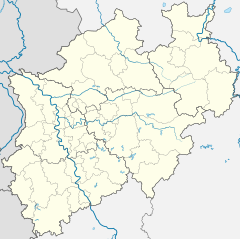| Through station | |||||||||||
 | |||||||||||
| General information | |||||||||||
| Location | Mettmann, North Rhine-Westphalia Germany | ||||||||||
| Coordinates | 51°13′40″N 6°57′11″E / 51.2279°N 6.9531°E | ||||||||||
| Line(s) | |||||||||||
| Platforms | 2 | ||||||||||
| Other information | |||||||||||
| Station code | n/a | ||||||||||
| DS100 code | KNEA [1] | ||||||||||
| Fare zone | VRR: 540 and 640[2] | ||||||||||
| History | |||||||||||
| Opened | 15 September 1879 [3] | ||||||||||
| Services | |||||||||||
| |||||||||||
| |||||||||||
Neanderthal station is a Rhine-Ruhr S-Bahn station in the town of Mettmann in the German state of North Rhine-Westphalia. It was opened on 15 September 1879. It is located in the Neandertal (Neander Valley), which prior to the German spelling reform of 1901 was spelled as Neanderthal.
The reason why the outdated spelling of the station was not updated is not clear. In German, even the spelling of the Neanderthal man (whose fossils were first found in the area) has been updated to Neandertaler from the outdated Neanderthaler. The nearby Neanderthal Museum and the municipality of Mettmann have adopted the policy that all names referring to the prehistoric humans have the "h", so they in fact use the spelling Neanderthaler for the species, which is not done anywhere else anymore in German-speaking areas, but even they do not spell the valley in the outdated way anymore (except seemingly in the name of the museum, which is in fact English, not German). The municipality claims that the German rail authority would not change the spelling because of the proximity of the museum.[4]
- ^ Eisenbahnatlas Deutschland (German railway atlas) (2009/2010 ed.). Schweers + Wall. 2009. ISBN 978-3-89494-139-0.
- ^ "Wabenplan für das Rheinbahn-Bedienungsgebiet" (PDF). Rheinbahn. 1 August 2008. Retrieved 31 October 2019.
- ^ "Neanderthal station operations". NRW Rail Archive (in German). André Joost. Retrieved 17 December 2013.
- ^ "Neandertal oder Neanderthal? - Was ist denn nun richtig?" (in German). Town of Mettmann. Retrieved 17 December 2013.


